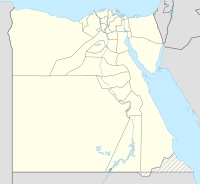| Operation Bertram | |
|---|---|
 Constructing a dummy tank at the Camouflage Training & Development Centre at Helwan, near Cairo, photo by Captain Gerald Leet (1942) | |
| Operational scope | Whole of Eighth Army |
| Location | 30°50′N 28°57′E / 30.833°N 28.950°E |
| Planned by | Strategy: Dudley Clarke, Charles Richardson Tactics: Geoffrey Barkas |
| Objective | 1) to conceal preparations for the real attack in north 2) to suggest attack in south 3) to minimise apparent scale of overt preparations in north 4) to suggest attack would not be ready for 2–3 days[1] |
| Date | September–October 1942 |
| Executed by | Middle East Command Camouflage Directorate |
| Outcome | Complete tactical surprise |
Operation Bertram was a Second World War deception operation practised by the Allied forces in Egypt led by Bernard Montgomery, in the months before the Second Battle of El Alamein in 1942. Bertram was devised by Dudley Clarke to deceive Erwin Rommel about the timing and location of the Allied attack. The operation consisted of physical deceptions using dummies and camouflage, designed and made by the British Middle East Command Camouflage Directorate led by Geoffrey Barkas. These were accompanied by electromagnetic deceptions codenamed Operation Canwell, using false radio traffic. All of these were planned to make the Axis believe that the attack would take place to the south, far from the coast road and railway, about two days later than the real attack.
Bertram consisted of the creation of the appearance of army units where none existed and in concealing armour, artillery and matériel. Dummy tanks and guns were made mainly of local materials including calico and palm-frond hurdles. Real tanks were disguised as trucks, using light "Sunshield" canopies. Field guns and their limbers were also disguised as trucks, their real wheels visible, under a simple box-shaped "Cannibal" canopy to give the shape of a truck. Petrol cans were stacked along the sides of existing revetted trenches, hidden in the shadows. Food was stacked in piles of boxes and draped with camouflage nets to resemble trucks.
Trucks were parked openly in the tank assembly area for some weeks. Real tanks were similarly parked openly, far behind the front. Two nights before the attack, the tanks replaced the trucks, being covered with "Sunshields" before dawn. The tanks were replaced that same night with dummies in their original positions, so the armour remained seemingly two or more days' journey behind the front line. To reinforce the impression that the attack was not ready, a dummy water pipeline was constructed, at an apparent rate of 5 mi (8.0 km) per day. Some days' worth remained to be built at the time of the attack; dummy tanks, guns and supplies were constructed to the south.
After the battle, the captured German Panzerarmee general Wilhelm Ritter von Thoma told Montgomery that he had believed the Allies had at least one more armoured division than they did and that the attack would be in the south. Rommel's stand-in, general Georg Stumme, thought the attack would not begin for several weeks. Bertram had succeeded; when announcing the victory at El Alamein in the House of Commons, Winston Churchill praised the camouflage operation.
- ^ Barkas & Barkas 1952, p. 191.
